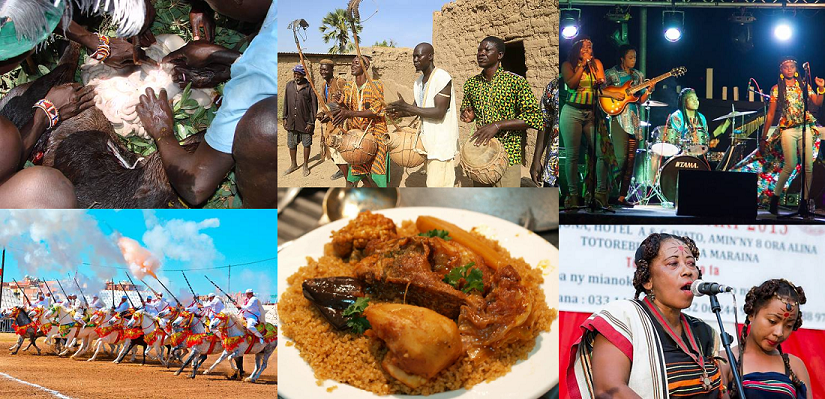The Unesco Intergovernmental Committee for the Safeguarding of the Intangible Cultural Heritage met online from 13 to 18 December and inscribed, for this year 2021, 4 new elements on the List of Intangible Heritage in Need of Urgent Safeguarding, including one cultural element from Africa, and 39 new elements on the Representative List of the Intangible Cultural Heritage, including 6 African cultural elements. This makes a total of 7 cultural elements from Africa inscribed on UNESCO’s intangible heritage lists in 2021.
Under the chairmanship of Punchi Nilame Meegaswatte, Secretary General of the Sri Lanka National Commission for UNESCO, the organization says, the committee also added four projects to the Register of Good Practices in Safeguarding Intangible Cultural Heritage. In addition, in the framework of international financial assistance from the Intangible Cultural Heritage Fund, the Committee granted US$172,000 to a project presented by Mongolia, US$116,400 to a project presented by Djibouti and US$266,000 to a project presented by Timor-Leste.
For the first time this year, the Committee inscribed elements from Congo, Denmark, Haiti, Iceland, the Federated States of Micronesia, Montenegro, the Democratic Republic of Congo, Seychelles and Timor-Leste on UNESCO’s intangible heritage lists. They now include 630 elements from a total of 140 countries.
Below are the 7 African elements inscribed by UNESCO, by category and by country.
Category: Inscriptions on the Urgent Safeguarding List of Intangible Cultural Heritage.
The List of Intangible Cultural Heritage in Need of Urgent Safeguarding identifies elements of living heritage whose survival is threatened. It allows for the mobilization of international cooperation and assistance to strengthen the transmission of these cultural practices in agreement with the communities concerned. It now includes 71 elements.
Country: Mali
Listed element: Cultural practices and expressions related to the “M’Bolon”, a traditional percussion musical instrument
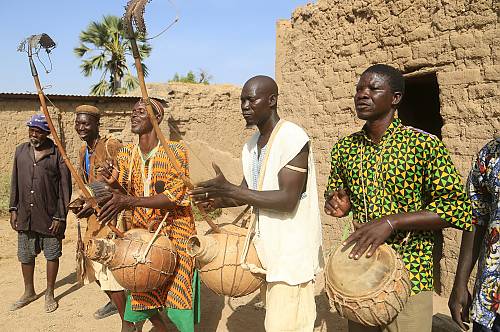
The M’Bolon is a musical instrument used in southern Mali. It is made up of a large calabash resonance box covered with cowhide and a wooden neck in the shape of a bow with strings. The number of strings on the M’Bolon determines how it is used. The one- and two-stringed M’Bolon are used in popular events, rituals and religious ceremonies, while the three- and four-stringed M’Bolon are used to accompany the praise of traditional chiefs, to celebrate the heroic deeds of kings and to accompany farmers in the fields. The practice of this instrument is taught in apprenticeships and by local associations.
Category: Elements added to the Representative List of the Intangible Cultural Heritage of Humanity .
This Representative List of the Intangible Cultural Heritage of Humanity aims to give greater visibility to the traditions and skills carried by communities. This list currently contains 492 elements.
Country: Democratic Republic of Congo and Republic of Congo
Listed element : Congolese Rumba

Congolese Rumba is a musical genre and dance popular in urban areas of the Democratic Republic of the Congo and the Republic of the Congo. Usually performed by a male and female couple, it is a form of multicultural expression that originates from an ancient dance called nkumba (“size” in Kikongo). Rumba is used in celebrations and on days of mourning, in public, private and religious spaces. It is accompanied by orchestras, choirs, dancers and solo musicians, both professional and amateur. Women have played a prominent role in the development of the romantic and religious style. The Congolese rumba tradition is passed on to younger generations through neighbourhood clubs, formal training schools and community organisations. For example, rumba musicians maintain clubs and train apprentice artists to perpetuate the practice and make instruments. Rumba also plays an important economic role, as the formation of orchestras enables the development of a form of cultural entrepreneurship aimed at reducing poverty. It is considered an essential and representative part of the identity of the Congolese people and its diaspora populations. It also allows the transmission of social and cultural values of the region, but also the promotion of social, intergenerational and solidarity cohesion.
Country :Seychelles
Listed element: the Moutya
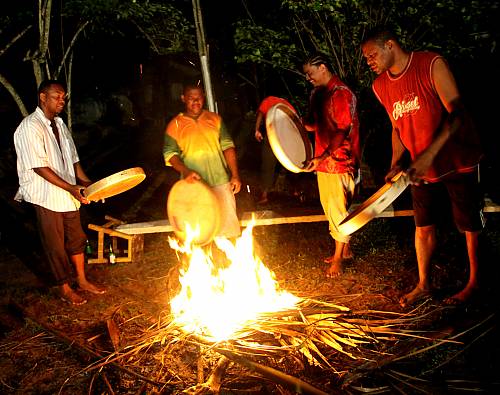
The Moutya was introduced to the Seychelles by the African slaves who arrived with the French settlers in the early 18th century. At the time, this dance was traditionally performed at night in the forest, at a distance from the plantation where their masters lived. The Moutya was originally performed as a psychological comfort against hardship and poverty and as a means of resisting servitude and social injustice. The dance is sensual, with simple choreography and is traditionally performed around a bonfire. The musical instrument used is a large, narrow-framed goatskin drum, played mainly by men. The dance begins with the drums being heated over the fire. Once the drums are warm, the musicians set the rhythm while the men in the crowd call out various themes, usually social comments, to which the women dancers respond in a high-pitched voice. The men and women then begin to dance in a moderate tempo, rolling their hips and stamping their feet. The dancers approach each other, but do not touch. Even today, the Moutya is a form of cultural identity expression that has retained its original form. It is usually performed spontaneously within the community, but also at social gatherings and cultural events. Moutya is transmitted informally through practice, observation and imitation, and formally through research, documentation and dissemination.
Country: Madagascar
Listed element: Kabary malagasy, Malagasy oratory art
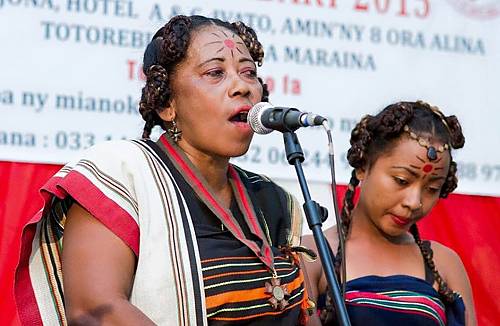
The Malagasy kabary is a poetic speech declaimed before an audience. It is very structured and consists of proverbs, maxims, figures of speech and puns. This ritualistic style of oratory was originally used by rulers to inform the community of social events and administrative decisions. Over time, it began to be used by communities to communicate and appeared at social events. It has thus become an integral part of social life in Madagascar, whether during festivities, funerals, official ceremonies or popular events. Its function is to express values and thoughts that give a collective meaning to material facts. In practice, the Malagasy kabary takes place as a conventional dialogue that usually involves two speakers or mpikabary, in front of an assembly. It can last several hours, but in certain circumstances (for example during funerals), its structure is simplified and it lasts only about ten minutes. It was traditionally performed by older men of high social status, but nowadays it is increasingly performed by young people and women. At the family level, it contributes to cohesion when it is performed at family gatherings where all generations are present and participate in the performance. In the public sphere, it is seen as a means of strengthening relations between groups and communities, creating an atmosphere of sharing and cohesion.
Country: Senegal
Listed element: Ceebu jën, a culinary art of Senegal
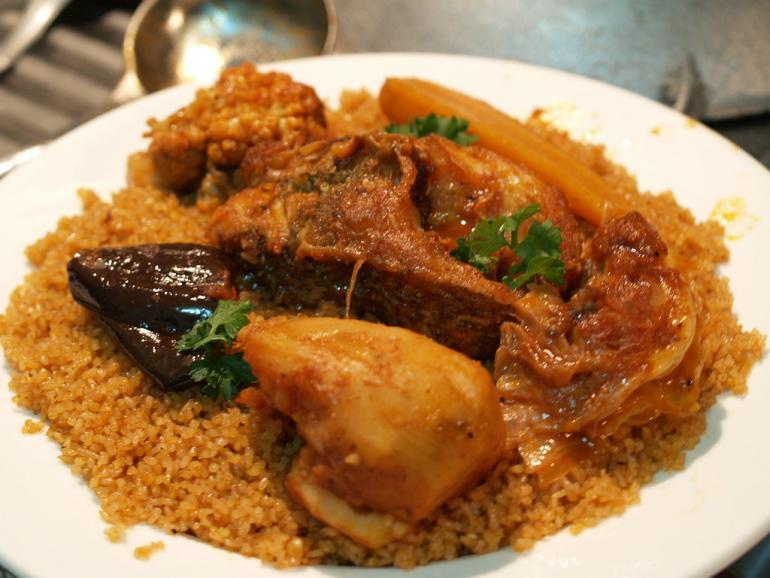
Ceebu jën is a dish that has its origins in the fishing communities of the island of Saint-Louis in Senegal. Although recipes vary from region to region, the dish is generally made with fish steaks, broken rice, dried fish, molluscs and seasonal vegetables, such as onions, parsley, garlic, chilli, tomatoes, carrots, aubergines, white cabbage, cassava, sweet potato, okra and bay leaves. The quality of the fish and the choice of vegetables are determined by the importance of the event or the degree of affection for the guest. The recipe and preparation techniques are traditionally passed down from mother to daughter. In most families, ceebu jën is eaten by hand, but it is often customary to use spoons or forks in restaurants. The dish is also linked to specific cultural practices. For example, it is forbidden to sit with one knee raised, the bowl must be held with the left hand and the rice grains must not fall out while eating. Ceebu jën and its associated practices are seen as an affirmation of Senegalese identity.
Country: Morocco
Listed item: the tbourida
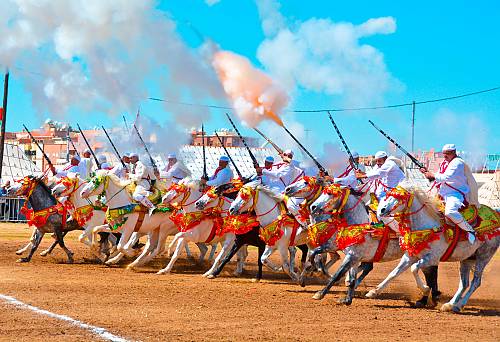
The tbourida is an equestrian performance that appeared in the 16th century. It simulates a succession of military parades, re-enacted according to ancestral Arab-Amazigh conventions and rituals. Each tbourida parade is performed by a troop made up of an odd number of riders and horses (from 15 to 25), lined up side by side and in the middle of which the leader of the troop is placed. Often, before the event, the riders give their performance a spiritual significance, performing their ablutions and then praying collectively. Together, under the direction of the leader, riders and horses perform a parade consisting of two main parts. The first is the hadda, or salute of the troop, which trots into the arena and performs an acrobatic display of arms, then repositioning itself to its starting point. The second is the talqa, where the troops gallop off and perform a blank gun salute before retreating, simulating a collective departure to war. The riders wear period costumes and accessories including a turban, draped clothing, slippers, a small booklet of the Koran and an ancient Arab sword. The horses are harnessed with traditionally sewn and decorated equipment. The riders come from the same tribe or region, whose customs and costumes they represent. They are passed on from generation to generation within families, through oral tradition and observation of practitioners.
Category: entries in the Register of Good Safeguarding Practices
This Register promotes the sharing of successful safeguarding experiences and examples of good practice in transmitting living heritage and its practice and knowledge to future generations. The Register now has 29 good practices.
Country: Kenya
Listed Item : Successful promotion of traditional foods and safeguarding of traditional diets in Kenya
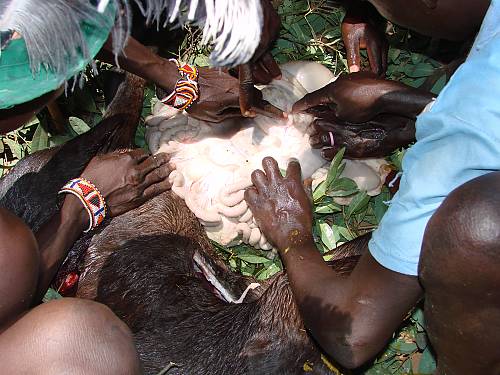
In Kenya, traditional diets were threatened by historical factors and the pressure of modern lifestyles. Local foods were despised and associated with poverty and underdevelopment. Recognising that a decline in dietary diversity and knowledge would have serious ramifications for health, nutrition and food security, Kenya committed itself in 2007 to safeguarding traditional food practices and expressions. Two major initiatives were launched in collaboration with scientists and community groups. The first was the mapping of traditional foods, particularly traditional vegetables. About 850 indigenous plants, identified by their local names, were inventoried. Detailed documentation was then prepared on their use, indicating related indigenous knowledge (including recipes) and practices (e.g. ceremonies). Rigorous promotion of these foods was then put in place. In the second initiative, UNESCO, in partnership with the Department of Culture and the National and International Museums of Kenya, and in consultation with community representatives, launched a pilot project to identify and inventory traditional foodways in partnership with primary school children. The aim was to raise awareness of the threats to these diets. These two initiatives have since given rise to other related activities carried out independently by local institutions. Several similar initiatives have been launched in other communities in Kenya, Ethiopia and Burkina Faso.
